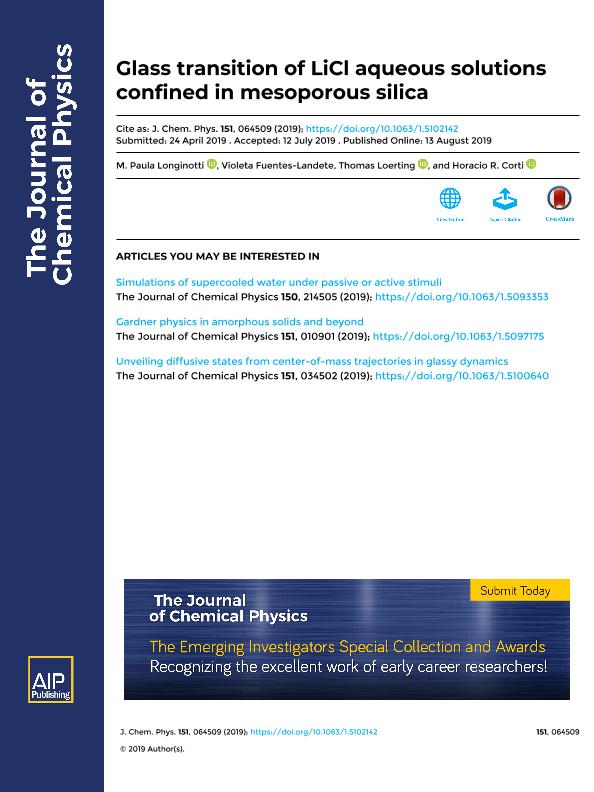Artículo
Glass transition of LiCl aqueous solutions confined in mesoporous silica
Fecha de publicación:
08/2019
Editorial:
American Institute of Physics
Revista:
Journal of Chemical Physics
ISSN:
0021-9606
Idioma:
Inglés
Tipo de recurso:
Artículo publicado
Clasificación temática:
Resumen
The thermal transitions of confined LiCl aqueous solutions were studied by differential scanning calorimetry for solutions with salt concentrations with eutectic (R = 7) and subeutectic (R > 7) compositions (R = moles of water/moles of LiCl). The confinement media consist of mesoporous silica with pore diameters between 2 nm and 58 nm, with a small negative surface charge density. The vitrification of confined LiCl aqueous solutions was observed in all samples, expanding the vitrification region up to R = 15, and probably beyond for cooling rates of ≈1000 K/min. Ice crystallization was observed in some samples, except for those confined in the narrower pores. The onset and endpoint glass transition temperatures for the confined eutectic samples increase by 2 K and 5 K, respectively, for the smallest pore diameters (2 nm), which is equivalent to the effect of applying a pressure of up to 100 MPa to the bulk sample. This behavior is opposite of that reported for aqueous subeutectic NaCl solutions confined in silica glasses of similar sizes. We speculate that this is due to the fact that the mechanism of double confinement of the NaCl solution, between the pore wall and the precipitated ice, is not operative for LiCl solutions. Instead, the Li+ ions might force the hydration water in to a high-density state.
Palabras clave:
glass transition
,
LiCl
,
confinement
,
aqueous solutions
Archivos asociados
Licencia
Identificadores
Colecciones
Articulos(INQUIMAE)
Articulos de INST.D/QUIM FIS D/L MATERIALES MEDIOAMB Y ENERGIA
Articulos de INST.D/QUIM FIS D/L MATERIALES MEDIOAMB Y ENERGIA
Citación
Longinotti, María Paula; Fuentes Landete, Violeta; Loerting, Thomas; Corti, Horacio Roberto; Glass transition of LiCl aqueous solutions confined in mesoporous silica; American Institute of Physics; Journal of Chemical Physics; 151; 6; 8-2019; 1-12
Compartir
Altmétricas




